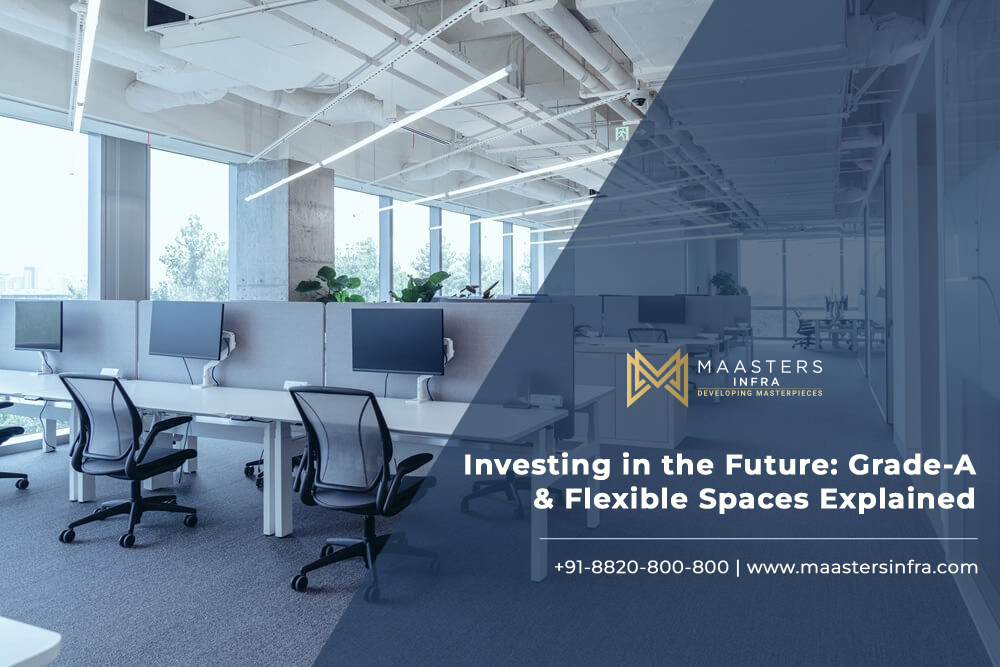In 2025, businesses are increasingly choosing Grade-A and flexible commercial workspaces for talent attraction, productivity, and resilience. This blog explores the drivers, benefits, challenges, and what investors, occupiers and landlords should watch next.
Introduction
The workplace keeps changing — fast. In 2025, two clear winners have emerged in commercial real estate: Grade-A office spaces and flexible commercial spaces (co-working, hybrid floors, plug-and-play suites). While Grade-A properties promise prestige, tech readiness and long-term stability, flexible spaces deliver agility, shorter leases and operational ease. Together they’re reshaping where and how companies choose to work.
Why demand is rising now
Several overlapping forces are driving demand:
• Hybrid work norms solidified. Companies want headquarters and collaboration hubs, not empty cubicle farms. Grade-A buildings with modern amenities become focal points for in-person collaboration, while flexible spaces absorb variable headcount and short-term needs.
• Talent competition. Top talent expects comfortable, transit-connected workplaces with wellness, F&B and green spaces — features typical of Grade-A developments.
• Technology & ESG pressures. Firms prioritize buildings with advanced digital infrastructure, energy efficiency and sustainability certifications — areas where Grade-A stock tends to lead.
• Operational simplicity for startups & SMEs. Flexible spaces provide plug-and-play solutions, lower upfront CAPEX and predictable OPEX, making them ideal for fast-growing businesses.
• Investor appetite for resilience. Institutional investors favor Grade-A offices for long leases and creditworthy tenants, while alternative investors chase higher-yield flexible space models.
What makes a Grade-A office attractive in 2025
Grade-A today means more than shiny lobbies:
• Robust digital backbone: fiber, redundant connectivity, smart-building systems and strong mobile coverage.
• Health & wellness design: touchless tech, improved HVAC and ample daylight.
• Sustainability: energy performance (e.g., net-zero initiatives), green certifications and circular building practices.
• Amenities & mixed-use integration: on-site food, fitness, outdoor spaces and retail to support the full employee experience.
• Transit and last-mile access: proximity to metro lines, major roads and micromobility options.
These features drive longer tenancy, higher rents per sq. ft., and stronger capital values.
The flexible space advantage
Flexible commercial spaces complement Grade-A stock — and sometimes rival it:
• Shorter, scalable commitments: month-to-month or multi-month terms let companies scale up or down quickly.
• Turnkey operations: furniture, reception, IT and services included — faster time to productivity.
• Community & programming: events, networking and shared services add intangible value for startups and remote-heavy teams.
• Geographic experimentation: businesses can test markets without heavy capital outlay.
Operators who combine strong tech, data on occupancy, and flexible pricing models are winning market share.
Who benefits — and how
• Large corporates: use Grade-A HQs to centralize culture and attract talent; use flexible spaces for project teams or satellite offices.
• SMEs & startups: gain from flexible spaces’ lower entry costs and networking opportunities.
• Landlords & investors: Grade-A assets deliver stability; adding flexible offerings (flex floors, managed office arms) can increase yield and occupancy.
• Cities & neighborhoods: well-designed office stock brings footfall, supporting retail and public transport sustainability.
Challenges & risks
• Oversupply in some micro-markets can pressure rents — location still matters.
• Operational complexity for landlords adding flexibility — success requires professional operators and tech platforms.
• Changing regulation & planning (zoning for mixed use, tax treatment) can affect feasibility.
• Talent shifts — if remote work intensifies again, demand patterns could change; diversification is key.
Practical takeaways for stakeholders
For occupiers
• Prioritize connectivity, sustainability and wellness when selecting Grade-A HQs.
• Use flexible spaces strategically: satellite hubs, project teams, or regional trials before committing to long leases.
For landlords & developers
• Consider hybrid product strategies: dedicate certain floors to flexible operations, or partner with established operators.
• Invest in smart building tech and ESG — tenants and capital demand it.
• Focus on experience design (amenities, F&B, events) — it’s a differentiator.
For investors
• Grade-A assets remain core, low-volatility plays.
• Flex space platforms present higher growth but require operational expertise — due diligence on operator economics is essential.
• Target markets with strong talent pools, transport links and limited speculative supply.
Looking ahead
Through 2025 and beyond, the healthiest office markets will be those that blend stability with agility. Grade-A buildings anchored by long-term tenants will coexist with nimble flexible operators, often within the same asset. The winners will be owners and operators who prioritize technology, sustainability and occupant experience — and who can pivot product offerings as occupier needs evolve.
Conclusion
The rise in demand for Grade-A and flexible commercial spaces signals a market maturing beyond “office vs remote” debates. It’s about delivering the right space, at the right time, with the right experience. Whether you’re an occupier, investor, or developer, the strategy for 2025 is clear: invest in quality, operational flexibility, and people-centred design

